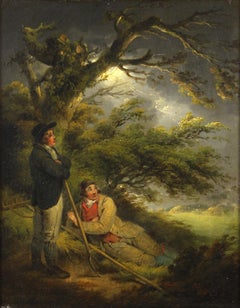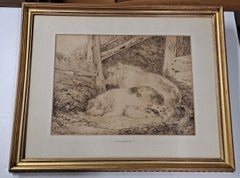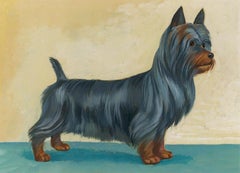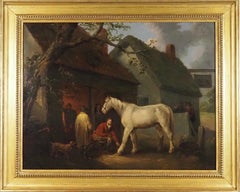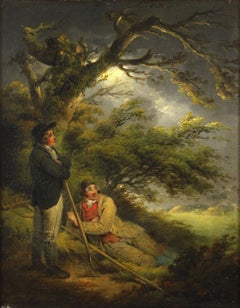George Morland Paintings
English, 1763-1804
George Morland (26 June 1763 in London – 29 October 1804 in Brighton) was an English painter. His early work was influenced by Francis Wheatley but after the 1790s he came into his own style. His best compositions focus on rustic scenes: farms and hunting; smugglers and gypsies; and rich, textured landscapes informed by Dutch Golden Age painting.to
3
1
Overall Width
to
Overall Height
to
4
4
3
1
4
3
1
1
1
1
1
4
2
2
1
8
780
723
710
686
4
2
2
Artist: George Morland
Sheltering from the storm / - Romantic landscape illuminated by lightning bolt -
By George Morland
Located in Berlin, DE
George Morland (1763 London - 1804 Brighton). Sheltering from the Storm. Oil on canvas, relined, 37.5 x 29.5 cm (visible size), 53.5 x 45.5 cm (...
Category
1790s Romantic George Morland Paintings
Materials
Oil
“Pair of Hunt Scenes, Oil on Canvas”
By George Morland
Located in Warren, NJ
This is 2 original oil paintings. Both are beautiful pieces. each lined and with craquelure; Meet by the Farmhouse with a chip in the paint along the left edge and an abrasion along ...
Category
18th Century George Morland Paintings
Materials
Oil
George Morland (1763-1804) "Piglets" Original Watercolor
By George Morland
Located in San Francisco, CA
George Morland (1763-1804) "Piglets" original watercolor on paper
Signed & Dated 1791
Unframed 14" x 18"
Framed 21" x 26"
Category
18th Century George Morland Paintings
Materials
Watercolor
Conversation at the gate
By George Morland
Located in Douglas, Isle of Man
George Morland 1763-1804, was an English painter who was influenced by the painter Francis Wheatley , landscapes. After 1790 he had developed his own style of painting adopting rusti...
Category
18th Century George Morland Paintings
Materials
Watercolor, Paper
Related Items
Blue mountain. 1975. Watercolor on paper, 14x19 cm
Located in Riga, LV
Blue mountain. 1975. Watercolor on paper, 14x19 cm
Herberts Mangolds (1901-1978)
Graphic, army officer.
In 1920 he graduated from the Artillery Cadet School of Latvian and many mili...
Category
1970s Realist George Morland Paintings
Materials
Paper, Watercolor
$228 Sale Price
20% Off
H 5.52 in W 7.49 in D 0.04 in
Silky Terrier Painting
Located in New York, NY
Original gouache, probably Belgian for matchbox covers. Mid-20th Century.
Category
Mid-20th Century George Morland Paintings
Materials
Gouache, Board
Late 1800s Naturalist Country Scene in Gouache on Paper
Located in Soquel, CA
Rich and detailed country landscape by an unknown artist (19th Century). A grove of large oak trees is carefully rendered on the right side of the composition. In the center, there a...
Category
Late 19th Century Naturalistic George Morland Paintings
Materials
Paper, Gouache
$540 Sale Price
20% Off
H 10.5 in W 12.13 in D 0.13 in
Mid Century Lake Anza Berkeley Bay Area Abstract Expressionist Landscape W/C
By Howard Margolis
Located in Soquel, CA
Brilliantly colorful mid century expressive abstracted landscape of Lake Anza in Berkeley by Bay Area artist Howard Margolis (American, 1927-2015). Signed “Margolis” in lower right c...
Category
Late 20th Century Abstract Expressionist George Morland Paintings
Materials
Paper, Watercolor
Howard MargolisMid Century Lake Anza Berkeley Bay Area Abstract Expressionist Landscape W/C, c.1960s
$850
H 10.75 in W 13.75 in D 0.5 in
At the sea. 2020, Watercolor, paper, 61 x 62 cm
By Zigmunds Snore
Located in Riga, LV
At the sea. 2020, Watercolor, paper, 62,5 x 85 cm
Zigmunds Šņore was born in 1942 in Latvia. His works has been exhibited since 1969 and are held in private collections in Latvia, ...
Category
2010s Realist George Morland Paintings
Materials
Paper, Watercolor
$667 Sale Price
20% Off
H 24.61 in W 33.47 in D 0.04 in
The Glow of the Past: Lundström’s Stockholm with a Touch of Mystery
Located in Stockholm, SE
We are pleased to present this painting by Ernst Lundström, dedicated to the esteemed sculptor Per Hasselberg. The dedication on the front of the painting makes this piece particular...
Category
1880s Romantic George Morland Paintings
Materials
Canvas, Oil
$3,455
H 21.07 in W 17.13 in
"Elegant Figures Seated in a Park" 19th Century Oil on Panel by M. Alonso Pérez
By Mariano Alonso Pérez
Located in Madrid, ES
MARIANO ALONSO PÉREZ
Spanish, 1857 - 1930
ELEGANT FIGURES SEATED IN A PARK
signed, located and dated "Alonso Pérez, Paris ´91" (lower right)
oil o...
Category
Early 1900s Romantic George Morland Paintings
Materials
Oil, Wood Panel
Boats Along the Wharf Landscape
By Henry Hank Volle
Located in Soquel, CA
Beautiful watercolor landscape of boats along the wharf by Henry Hank Volle (American, 20th Century). Presented in a rustic wooden frame. Signed "Henry Volle" lower left. Artists bio...
Category
1970s American Impressionist George Morland Paintings
Materials
Paper, Watercolor
$700 Sale Price
20% Off
H 25 in W 31.25 in D 1 in
A Scandinavian Landscape View by Swedish Artist Oscar Lycke, Large Size Painting
Located in Stockholm, SE
Oscar Lycke was a Swedish artist from Sundsvall. He is best known for his impressive colourful landscape paintings in a national romantic and realism styl...
Category
1920s Romantic George Morland Paintings
Materials
Canvas, Oil
$3,306 Sale Price
25% Off
H 41.15 in W 58.08 in
20th century English Impressionist town scene, possibly France
By Jack Griffin
Located in Woodbury, CT
A wonderful oil on panel by Jack Griffin. Jack was an English Impressionist painter who mostly painted in the Southern part of the UK. He also travelled to Holland and Northern Franc...
Category
1970s Impressionist George Morland Paintings
Materials
Oil, Panel
$2,360 Sale Price
20% Off
H 18 in W 24 in D 2 in
Bright Green Impressionist Landscape with Figure in Dunes Mid 20th Century
By Claude Marin
Located in Cirencester, Gloucestershire
Impressionist Landscape
by Claude Marin (French 1914-2001)
signed oil on canvas, framed
Framed: 19 x 22 inches
Canvas : 13.5 x 16.5 inches
Inscribed Verso
Provenance: private collect...
Category
Mid-20th Century Impressionist George Morland Paintings
Materials
Oil
Horse Drawn Plough with Two Horses Ploughman and Dog by British Landscape Artist
By James Wright
Located in Preston, GB
Horse Drawn Plough with Two Horses, Ploughman and his Dog. Signed, Oil on Canvas, housed in a gilt frame, by British Landscape Artist, James Wright.
Art measures 24 x 16 inches
Fram...
Category
1990s Romantic George Morland Paintings
Materials
Canvas, Oil
$3,240 Sale Price
20% Off
H 20 in W 30 in D 2.992 in
Previously Available Items
The Farrier
By George Morland
Located in Stoke, Hampshire
George Morland (1762-1804)
The Farrier
Signed and dated 'G Morland, 1793' lower left
Oil on canvas
Canvas Size - 27 5/8 x 36 in
Framed Size - 35 x 43 in
Geo...
Category
18th Century Old Masters George Morland Paintings
Materials
Oil
Sheltering from the storm - Romantic landscape illuminated by lightning bolt -
By George Morland
Located in Berlin, DE
George Morland (1763 London - 1804 Brighton). Sheltering from the Storm. Oil on canvas, relined, 37.5 x 29.5 cm (visible size), 53.5 x 45.5 cm (...
Category
1790s Old Masters George Morland Paintings
Materials
Canvas, Oil
A white horse sheltering from a storm
By George Morland
Located in Stoke, Hampshire
George Morland (1763-1804)
A white horse sheltering from a storm
Oil on canvas
Painting Size 11 3/8 x 13 3/4 in
George Morland was born in June 1763. An English painter, mainly of s...
Category
18th Century English School George Morland Paintings
Materials
Oil
George Morland, Figures drinking outside an Inn
By George Morland
Located in Harkstead, GB
A charming rustic scene with figures drinking outside a tavern. Painted on a lovely old oak panel with labels and a wax seal.
George Morland (1763-1804)
Figures outside an Inn
Oil on panel
With seal and labels to the reverse
7 x 6 inches
10 x 9 inches including the frame
George Morland (26 June 1763 in London – 29 October 1804 in Brighton) was an English painter. His early work was influenced by Francis Wheatley but after the 1790s he came into his own style. His best compositions focus on rustic scenes: farms and hunting; smugglers and gypsies; and rich, textured landscapes informed by Dutch Golden...
Category
Late 19th Century Old Masters George Morland Paintings
Materials
Oil, Wood Panel
GEORGE MORLAND R.A. - ORIGINAL OIL CANVAS - BOATS HEADING OUT ISLE OF WIGHT
By George Morland
Located in Marlow, Buckinghamshire
A beautiful original oil on canvas by George Morland R.A. the important english landscape and figure painter who worked din the 18th century. This large canvas depicts boats heading ...
Category
18th Century Old Masters George Morland Paintings
Materials
Oil
Barn Interior With Horses & Figures, circa 1800
By George Morland
Located in Blackwater, GB
Barn Interior With Horses & Figures, circa 1800
by GEORGE MORLAND (1763-1804) sales to $190,000
Large 18th Century English Barn interior scene with farm workers and various horses entering at the end of the days work, oil on canvas by George Morland. Excellent condition for its age, signed top right on the rag covering the window. Leading example of the artists work, presented in a good frame ready to hand and professionally relined and restretched (will not need any conservation for another 50 years). Rare leading example of the artists work.
Measurements: 46" x 36" framed approx
GEORGE MORLAND 1763-1804
George Morland was born in London on 26 June 1763. He was the son of Henry Robert Morland and grandson of George Henry Morland. He began to draw at the age of three and at the age of ten his name appears as an honorary exhibitor of sketches at the Royal Academy. He continued to exhibit at the Free Society in 1775 and 1776, and at the Society of Artists in 1777 before exhibiting again at the Royal Academy in 1778, 1779 and 1780.
His talents were carefully cultivated by his father, who was accused of stimulating them unduly with a view to his own profit, shutting the child in a garret to make drawings from pictures and casts for which he found a ready sale. The boy on the other hand, is said to have soon found a way to make money for himself by hiding some of his drawings and lowering them at nightfall out of his window to young accomplices, with whom he used to spend the proceeds in frolic and self-indulgence.
He was set by his father to copy pictures of all kinds, but especially of the Dutch and Flemish masters. Among others, he copied Fuseli's ‘Nightmare’ and Reynolds's ‘Garrick between Tragedy and Comedy’. He was also introduced to Sir Joshua Reynolds and obtained permission to copy his pictures and, all accounts agree, before he was seventeen he had obtained a considerable reputation not only with his friends and the dealers but among artists of repute. A convincing proof of skill in original composition, which he had then attained, is the fine engraving by William Ward after his picture of ‘Angler's Repast’ which was published in November 1780 by John Raphael Smith.
Morland went to Margate where he painted miniatures for a while and then paying a short visit to France in 1785, where his fame had preceded him and he had no lack of commissions. Returning to London, he lodged in a house, at Kensal Green on the road to Harrow, near to his friend William Ward whose family seems to have had a steadying influence. It resulted in Morland's marriage to Miss Anne Ward...
Category
19th Century George Morland Paintings
Materials
Canvas, Oil
A gentleman shooting in a landscape, with his horse and dog
By George Morland
Located in Stoke, Hampshire
George Morland (1763-1804)
A gentleman shooting in a landscape
Oil on canvas
17 7/8 x 24 1/8 in
45.5 x 61 cm
George Morland was born in June 1763. An English painter, mainly of scen...
Category
18th Century George Morland Paintings
Materials
Oil
Heading home with the days catch
By George Morland
Located in Stoke, Hampshire
GEORGE MORLAND (BRITISH 1762/63-1804)
Heading home with the days catch - Beach scene landscape
Signed with initials lower right
oil on canvas
28 x 36 in
George Morland was the eldes...
Category
18th Century George Morland Paintings
Materials
Oil
Winter Games - 18th Century Oil, Figures in Snow Landscape by George Morland
By George Morland
Located in Marlow, Buckinghamshire
A wonderfully painted oil on canvas by George Morland depicting children playing outside a cottage on a snowy winter's day. Signed lower right.
George Morland was the son of the pastel portraitist, dealer and restorer Henry Robert Morland and the grandson of the genre painter George Henry Morland. He was taught by his father and first exhibited at the Royal Academy at the age of fifteen. Until the age of twenty-one, he devoted his entire existence to his work, his only friend being the painter and engraver Philip Dawe. In 1784, George Romney offered him a position as his assistant, but Morland refused, because he wanted to enjoy his freedom. In any case, the young artist had already produced works that had met with great success, such as The Angler's Repast, which had been painted when he was barely seventeen years old and was reproduced by William Ward. At first Morland painted portraits in Margate and at St-Omer in France. In 1876 he went back to London, where he married the sister of the engraver William Ward. Shortly afterwards, Ward married Morland's sister, and this double alliance cemented a collaboration which provided the English School with a considerable number of attractive and interesting prints.
At the start of his career, Morland was mainly a painter of childhood. He depicted an English ideal of childhood in all its prettiness, with a pleasant, even witty touch. He had the gift of working with great ease and produced a large number of paintings in this genre. In the years 1788 and 1789 alone, no less than 59 engravings after Morland appeared. They were mezzotints of elegant scenes of childhood, executed by the finest artists.
From 1790, Morland broadened his range, painting a greater variety of subjects. Though children still appeared in some of his pictures, they rarely played the principal part in the way they had previously done. On the other hand, horses, sheep, pigs and poultry feature in a large number of canvases. It was also around this time that he produced his series of recruits and deserters, and his gypsies, fishermen, and scenes of inns and public coaches. He was earning a lot of money, but he was spending even more, and he was obliged to retreat to a country dwelling in Leicestershire. This stay in the country had a considerable influence on his talent and sharpened his taste for landscape.
When Morland returned to London in around 1792, he suffered the consequences of his past follies, as his creditors had obtained warrants for his arrest, and he lived in hiding for several years in order to avoid imprisonment. In the end he grew tired of this and in 1799 he took refuge in a cottage near Cowes on the Isle of Wight, which had been lent to him by a friend. He remained there for almost a year, living among the sailors and fishermen, where he found many typical faces he could use in his paintings. His return to London early in 1800 was swiftly followed by his imprisonment for debt. Briefly released in 1802, he was imprisoned again following an apoplectic fit, which left him unable to work. His wife survived him by only a few days.
Morland is an interesting figure in the English School, an artist full of charm and verve. He left a considerable body of work. According to his family, during the last eight years of his life, he produced around eight hundred paintings and more than a thousand drawings.
Museum and Gallery Holdings
Bath (Holburne Mus. of Art): Horse and Dog in a Stable (1791, oil on canvas); The Deserter Pardoned (1792, oil on canvas)
Birmingham (Mus. and AG): Pigs (oil on canvas); Shooting Sea Fowl (oil on canvas)
Bristol: Interior with Sheep
Bristol (City Mus. & AG): Quarry Scene (two); Gypsies in a Landscape (oil on canvas); Man Grooming Horse; Boy Seated on a Drinking Horse
Budapest: Pigsty
Dublin: Landscape with Figures and Cattle
Edinburgh: study
Glasgow: Smugglers on the Shore; Storm and Shipwreck; Seascape
Leeds (City AG): Coast Scene (oil on canvas)
Leicester: Calm Sea off the Isle of Wight
London (National Portrait Gal.): George Morland (c. 1775-1780, oil on canvas); Henry Robert Morland (pencil, father of the artist); George Morland (c. 1795, chalk)
London (Tate Collection): Inside of a Stable (exhibited in 1791, oil on canvas); Outside the Ale-House Door (1792, oil on canvas); Door of a Village Inn (oil on canvas); Rabbiting (1792, oil on canvas); The Fortune Teller (oil on canvas)
London (Victoria and Albert Mus.): Farmer Paying his Bill to the Innkeeper; Horses in a Stable; Fishermen; Fishing Boats with Figures; Girl Stroking a Pigeon; Johanny Going to the Fair; Hunting Scene; Farmyard; Cottage, Farm Cart and Dog
London (Wallace Collection): A Visit to the Boarding School (1789, oil on canvas)
Manchester: watercolours
Montreal (Learmont Collection): Village Brewery
New York: Town-Country
Nottingham (Castle Mus. & AG): The Wreckers; The Artist in his Studio; Sportsman Resting; Two Horses in the Snow...
Category
Late 18th Century Old Masters George Morland Paintings
Materials
Canvas, Oil
Travellers in Woodland Shelter Georgian Oil Painting
By George Morland
Located in Cirencester, Gloucestershire
Travellers Resting
Attributed to George Morland (British 1763-1804)
oil painting on canvas, framed
canvas: 28 x 34 inches
framed: 34.5 x 40 inches
Very fine antique English oil painting on canvas depicting this group of travellers resting under the protection of the mighty oak tree in this wooded landscape. The painting is of exceptional quality and may be attributed to the British painter, George Morland (1763-1804). It dates to the circa 1790-1800 period.
Painted on this grand, exhibition scale, the work beautifully captures this resting family, including the pet dog, taking shelter...
Category
Late 18th Century Victorian George Morland Paintings
Materials
Oil
Gypsies Resting in a Forest
By George Morland
Located in Saint Augustine, FL
An original signed oil on canvas by English artist George Morland (1763-1804), titled "Gypsies Resting in a Forest", c. 1790. Bears original brass plaque with title and art...
Category
1790s Realist George Morland Paintings
Materials
Canvas, Oil
George Morland paintings for sale on 1stDibs.
Find a wide variety of authentic George Morland paintings available for sale on 1stDibs. You can also browse by medium to find art by George Morland in paint, oil paint, canvas and more. Much of the original work by this artist or collective was created during the 18th century and is mostly associated with the Old Masters style. Not every interior allows for large George Morland paintings, so small editions measuring 6 inches across are available. Customers who are interested in this artist might also find the work of John Horace Hooper, Debra Reid Jenkins, and Daniel Van Der Putten. George Morland paintings prices can differ depending upon medium, time period and other attributes. On 1stDibs, the price for these items starts at $1,593 and tops out at $25,355, while the average work can sell for $8,577.
